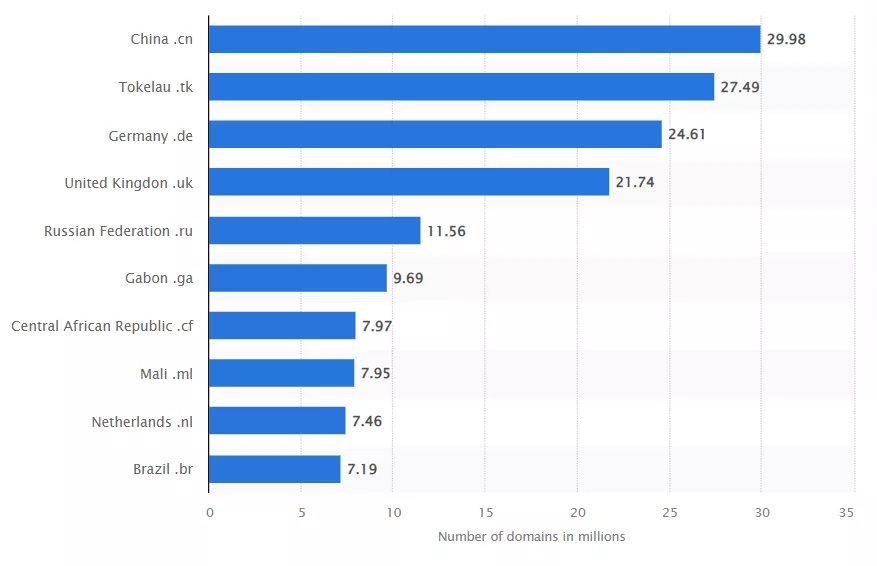In this article, I'll tell you about the types of top-level domains (TLDs) and the areas in which they are commonly used. The article also has a checklist to help you choose the right domain name and avoid common mistakes. Be sure to read till the end to learn where to buy valuable and popular TLDs.
What exactly is a TLD?
A domain is essentially an address for an online website. As opposed to a digital IP address, a domain is easy-to-remember and letter-based. Each domain name is unique, and it is impossible to register two identical domain names.
After the root domain, a Top-Level Domain (TLD) is one of the highest domains in the hierarchical Domain Name System of the Internet. For example, in the link www.google.com, the top-level domain is .com.
What does a TLD indicate?
A TLD indicates the key aspects of a domain name and how it is used:
- Website type or category. Many TLDs were created to identify specific organizations or groups. For example, the .com domain is mostly used by for-profit organizations, .org by nonprofit organizations, and .gov by government agencies.
- Geographical location. Country code top-level domains (ccTLDs), such as .uk, .fr, and .ca, indicate the geographical location of the activity or the website.
- Specialization or target audience. Newer generic TLDs (gTLDs), such as .travel, .tech, and .fashion, indicate a more specific sphere of influence or target audience for the website.
What types of top-level domains are there?
Domains are typically divided into generic and country code. Generic domains are created to indicate the scope of the resource. For example, .com is an abbreviation for the word “commercial”, and it is used for commercial businesses.
Country code domains are domains assigned to a specific country. You can check the number of country code domains worldwide on Statista.
The main types of TLDs
The structure of domain names involves not only website addresses but also a hierarchical relationship of levels. Each level indicates a website's general affiliation to a certain zone, geographical region, or specific field of activity. Let’s take a look at the main TLD types and their characteristics.
Generic top-level domains (gTLDs)
Such domains allow companies to more accurately reflect the content of their resource and help users find the site more easily:
- .biz - for businesses, an alternative to the crowded .com domain.
- .info - for general use by information websites.
- .name - for individual use to create a personal website or email with your name on it.
- .tech - for IT companies, technology startups, and individual engineers and enthusiasts.
- .travel - for travel agencies, airlines, and hotels.
Country code top-level domains (ccTLD)
These are top-level domains associated with a particular region or country. Each ccTLD consists of a two-character code according to the ISO 3166-1 international standard for encoding country names. For example, .uk stands for the United Kingdom, .ca for Canada, and .jp for Japan, etc.
Read a case study on promoting an English language website: how to go from 140 to 4,000 visits per month..
Sponsored top-level domains (sTLDs)
A sponsored TLD is a specialized category administered and maintained by sponsoring organizations. These organizations are from specific communities, interests, or industries and control who can register a domain in that sTLD. For example, .edu for educational institutions, .aero for aviation, and .coop for cooperatives.
Test top-level domains (tTLDs)
These are top-level domains created for testing and experimentation purposes only. They are closed to public use and are needed to test the operation of the Domain Name System (DNS), software development, etc. These domains include .test, .example, .invalid, and .localhost ; each has a clear purpose according to the recommendations of the IETF (Internet Engineering Task Force).
Generic restricted top-level domains (grTLD)
A subcategory of domains, generic restricted TLDs are open to the public but have restrictions on registration and use.
When you register such a domain with a specialized domain registrar such as GoDaddy, NameCheap, or Google Domains, you may be asked to complete a verification to confirm your identity, profession, etc. For example, the .pro domain was originally created for licensed professionals who had to prove their professional identity: doctors, lawyers, and engineers.
Infrastructural top-level domains (ARPA)
These are used in the technical infrastructure of the Internet to ensure the operation of critical network functions. The most popular is .arpa, which stands for Address and Routing Parameter Area. It is not intended for general use or registration:
| Domain Type | Example |
| Generic (gTLD) | .com, .org, .net, .info, .tech, .art, .photo |
| Country code (ccTLD) | .uk (Great Britain), .de (Germany), .ca (Canada), .us (USA), .br (Brasil), .in (India), .jp (Japan), .cn (China) |
| Sponsored (sTLD) | edu (educational institutions), .gov (government entities), .museum (museums), .aero (aerospace-related fields), .coop (cooperatives), .asia (Asia and the Pacific) |
| Infrastructural | .arpa (network infrastructure) |
| Generic restricted (grTLD) | .biz, .name, .pro, .asia |
| Test (tTLDs) | .test, .example, .invalid, .localhost |
Internationalized domain name (IDN)
There is a separate category of domains that denote both the country and the national language. These are IDNs (Internationalized Domain Names), where you will only find non-Latin alphabets, such as Cyrillic, Greek, or Arabic.
How to choose a domain name
Choosing the right domain name is an important part of website promotion. The name directly affects the branding, marketing, and memorability of your site. Here are some tips:
- Consider the length of the domain. Don't create a long name. A short one is easier to remember.
- Do not use special characters. Letters or numbers are better.
- Choose the right top-level domain. The .com domain is universal, but .info, .net, .org, or other narrower domains may be more appropriate for your site.
- Check availability. Once you have created a domain, check its availability and whether it violates copyrights.
- Ensure there are no other similar domains. It is important to make sure that there are no sites with similar domain names, especially in your industry.
Common mistakes when choosing a domain name
Here are some common mistakes to avoid:
- Ignoring trademarks. Registering a domain that is the same as or similar to someone else's trademark can lead to legal problems.
- Not considering the local aspect. If you do not take into account the geographical location, you will miss the opportunity to improve the website’s ranking using this parameter.
- Following trends. Popular names or slang quickly become outdated, and then you need to change your brand strategy.
- Insufficient research. You may accidentally choose a name that is too similar to another popular site, and this can confuse users.
What determines the price of a domain?
The price depends on the type, popularity, and reputation of certain TLDs, such as .com or .org. Domain name registrars set their own prices and may offer additional services, such as hosting or privacy protection, which also affect the final price. There may also be additional fees for renewing or transferring a domain to other owners.
Where to buy a TLD
The easiest way to obtain a domain name is to purchase one from hosting providers or organizations accredited by the Internet Corporation for Assigned Names and Numbers (ICANN). If you are looking for unique or valuable domain names that have already been registered, check platforms for buying and selling registered domain names, such as Sedo or Flippa.
How TLD affects Google rankings
Common TLDs do not directly affect rankings. Furthermore, Google claims their search engine does not favor any TLDs, except for ccTLDs for geotargeting.
Country code top-level domains, such as .uk for the United Kingdom or .fr for France, are important for localized search. A ccTLD helps a website rank better in a particular country, as Google sees it as a strong signal that the content is intended for a specific country. However, if you plan to expand in the future, keep in mind that country code domains make it more difficult to advertise outside the country.
FAQ
1. Where is the top-level domain located?
At the end of the domain name. For example, in the link www.google.com, the top-level domain is .com.
2. Where is the domain name located?
A domain name is displayed in the URL of the browser address used to access websites on the Internet.
3. How are domain names structured?
Domain names have a hierarchical structure consisting of a top-level domain (TLD), a second-level domain (SLD), and optional subdomains. They define a unique address for a website on the Internet and indicate its location on the World Wide Web.
4. What is .edu?
The .edu domain is one of the original top-level domains created in 1985. It is intended specifically for educational institutions, including colleges, universities, and academic communities.
Conclusions
A top-level domain (TLD) indicates the type or category of a website, its target audience, or geographic location.
- Domains are usually divided into generic domains and country code domains:
- Generic domain names indicate the industry, for example, .com for commercial enterprises, and .org for non-profit organizations, charitable foundations, and groups with common interests.
- Country code domain names indicate the country, for example, .uk for the United Kingdom, .fr for France, and .ca for Canada.
- The main types of TLDs:
- Generic top-level domains (gTLD)
- Country code top-level domains (ccTLD)
- Sponsored top-level domains (sTLDs)
- Test top-level domains (tTLDs)
- Generic-restricted top-level domains (grTLD)
- Infrastructural top-level domains (ARPA)
- Internationalized domains (IDNs) are a special category of domains. They are represented by characters that denote both the country and the national language.
- Considerations to keep in mind when choosing a domain name:
- Consider the length of the domain.
- Do not use special characters.
- Check the availability of similar domains.
- Common mistakes when choosing a domain name:
- Ignoring trademarks.
- Not considering the local aspect.
- Following trends blindly.
- Not doing enough research.
- You can buy a domain name directly from your hosting provider or from organizations accredited by the Internet Corporation for Assigned Names and Numbers (ICANN).
- The domain type does not affect advertising on Google, except for ccTLDs for geotargeting.
Related Articles
Display Advertising Effectiveness Analysis: A Comprehensive Approach to Measuring Its Impact
In this article, I will explain why you shouldn’t underestimate display advertising and how to analyze its impact using Google Analytics 4
Generative Engine Optimization: What Businesses Get From Ranking in SearchGPT
Companies that master SearchGPT SEO and generative engine optimization will capture high-intent traffic from users seeking direct, authoritative answers
From Generic to Iconic: 100 Statistics on Amazon Marketing for Fashion Brands
While traditional fashion retailers were still figuring out e-commerce, one company quietly revolutionized how U.S. consumers shop for everything from workout gear to wedding dresses




